RSC主编推荐:材料领域精彩文章快览(免费阅读原文)
英国皇家化学会(RSC)是一个超过175年历史的面向全球化学家的非营利会员制机构,旗下拥有44种期刊,其中很多在化学领域有很高影响力。为了进一步帮助广大读者追踪科技前沿热点,X-MOL团队与英国皇家化学会合作,推出英国皇家化学会期刊主编推荐的精彩文章快览,本期文章属“材料领域”,英文点评来自英国皇家化学会期刊的主编。如果大家对我们的解读有更多的补充和点评,欢迎在文末写评论发表您的高见!
Chemical Science (IF: 9.556)
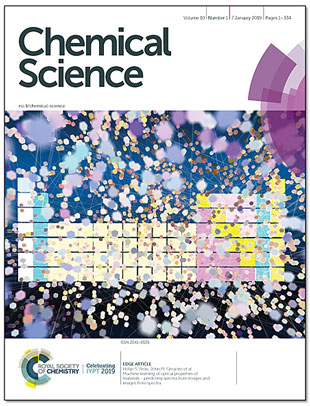
1. Uncovering two kinetic factors in the controlled growth of topologically distinct core–shell metal–organic frameworks
Chem. Sci., 2019, Advance Article
DOI: 10.1039/C9SC02576F
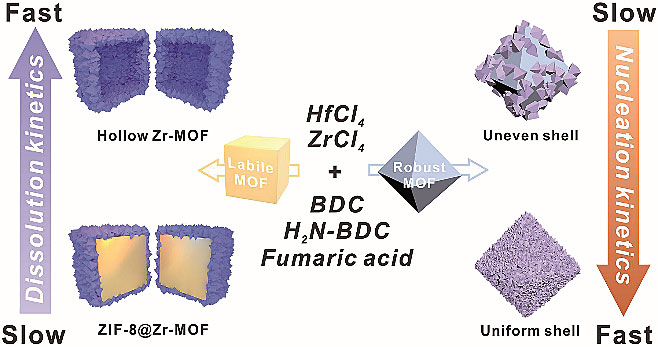
Researchers from ShanghaiTech University have revealed two kinetic factors - nucleation kinetics and dissolution kinetics - that determine the growth of uniform Zr/Hf-MOF shells on a series of cover MOFs. This is a promising approach to increase the complexity of MOFs and explore new functions. Nucleation kinetics controls the nucleus size of the shell MOF and therefore its surface coverage and uniformity on the core MOF. Dissolution kinetics determines how fast the core MOF dissolves during the growth process.
Open Access(可免费阅读原文)
扫描或长按二维码,识别后直达原文页面,或点此查看原文

2. Rational synthesis of three-dimensional core–double shell upconversion nanodendrites with ultrabright luminescence for bioimaging application
Chem. Sci., 2019, Advance Article
DOI: 10.1039/C9SC01586H

Scientists in China have made a new class of three-dimensional upconversion core–double-shell nanodendrites (UCNDs) including an active core (NaYF4:Yb,Er,Ca) capped by a transition layer (NaYF4:Yb,Ca) and an active outer shell (NaNdF4:Yb,Ca). The UCNDs exhibit enhanced upconversion luminescence emission by 5 and 15 times relative to reference truncated core–shell UCNPs and spherical core UCNPs, and were demonstrated as efficient long-term luminescent probes for in vitro and in vivo bioimaging.
Open Access(可免费阅读原文)
扫描或长按二维码,识别后直达原文页面,或点此查看原文

Materials Horizons (IF: 14.356)
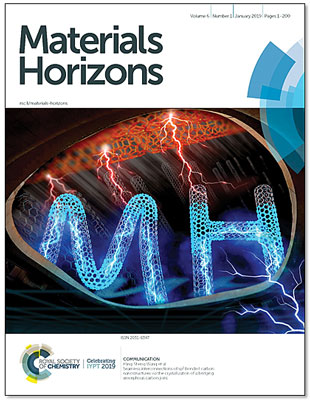
1. When defects become'dynamic': halide perovskites: a new window on materials?
Mater. Horiz., 2019, Advance Article
DOI: 10.1039/c9mh00606k
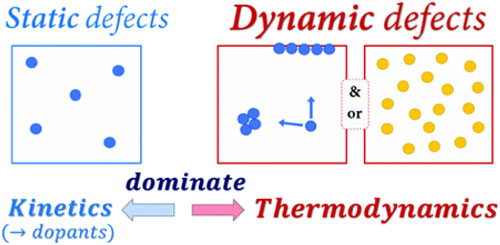
Although Pb Halide perovskites (HaPs) can be prepared as organic electronic materials, they resemble top-quality inorganic semiconductors, especially with respect to their low defect densities, as derived from optical and electronic transport studies. Among causes for such low defect densities were 'defect-tolerance' (proposed) and 'self-healing' (experimentally identified). We show that HaPs are likely an example of a class of materials that cannot support static bulk defect densities significantly above thermodynamically-dictated densities. The reasons are (a) the free energy to form HaPs (from binary halides) is less than the formation energies of (static) defects in them and (b) the small kinetic stabilization of such defects. We summarize the evidence for such a situation and conclude that higher defect densities in polycrystalline films likely result from the (expected) smaller defect formation energy at surfaces and grain boundaries than in the bulk. This situation directly limits the options for doping such materials, and leads to the counter-intuitive conclusion that a low free energy of formation (from the binaries) can lead to self-healing and, consequently, to low densities of static defects, to be distinguished from dynamic ones. The latter can be benign in terms of (opto)electronic performance, because of their relatively short lifetimes. We propose that the conditions that we formulated can serve as search criteria for other low defect density materials, which can be of interest and beneficial, also for applications beyond optoelectronics.
限时免费阅读原文,登录后可下载
扫描或长按二维码,识别后直达原文页面,或点此查看原文

2. A smart AIEgen-functionalized surface with reversible modulation of fluorescence and wettability
Mater. Horiz., 2019, Advance Article
DOI: 10.1039/c9mh00798a
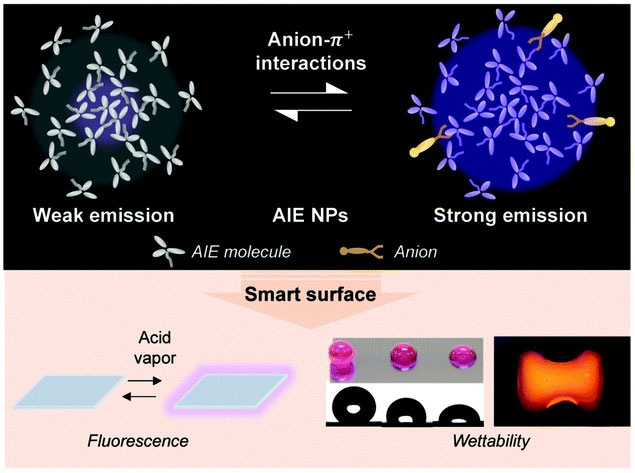
Aggregation-induced emission luminogens (AIEgens) are molecules in which the intramolecular motions can be the pathway to consume the energy from excitation. For the AIE molecules at the AIE nanoparticles (NPs)' surface, the restrictions of the surrounding environment to their intramolecular motions are much weaker compared to the embedded molecules in the core. This allows them to be further restricted, resulting in controllable emission properties of the AIE NPs. However, no paper on efficient control of molecular motions of the molecules on the AIE NPs' surface has been reported. This concept provides success in tuning the AIE NPs' emission intensity with ultrasensitive and fast response through the formation or dissociation of anion–π+ interactions of the NPs' surface molecules. Noteworthily, the AIE NPs can be further used to functionalize the surface, and the obtained AIEgen-functionalized surface realizes reversible modulation of fluorescence and wettability. The smart surface could meet the requirements for advanced sensing or wetting-dependent applications, such as controlling liquid droplet spreading and bacterial adhesion behavior. This concept not only provides a new strategy for tuning the fluorescence properties but also shows the ability of a functionalized surface in the applications of smart devices.
限时免费阅读原文,登录后可下载
扫描或长按二维码,识别后直达原文页面,或点此查看原文

3. Suppression of electron trapping by quantum dot emitters using a grafted polystyrene shell
Mater. Horiz., 2019, Advance Article
DOI: 10.1039/c9mh00551j
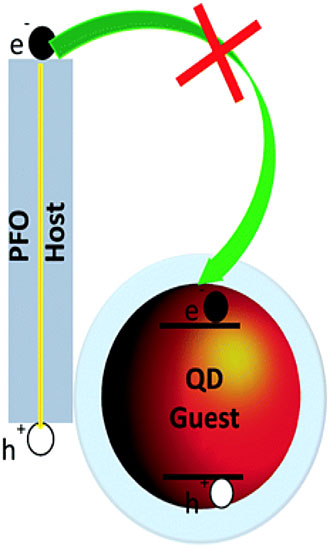
In displays it is important to have small linewidths to make saturated colors. This is why nowadays quantum dots (QDs) are being used as phosphor, meaning that they convert light generated by a blue/white LED backlight. An even more attractive device would be to incorporate the QDs directly in an electroluminescent device such that no backlight is needed, the QD LED. However, until now this approach only works when a very thin emissive layer containing only a few monolayers of QDs is used, surrounded by a number of organic transport and confinement layers, of which the thickness is very critical. A major problem is that in the QD emissive layer the charge transport needs to be exactly balanced, otherwise the layer gets charged with one type of carrier, which blocks the current. The way out to a robust and simple structure would be to use a thicker layer where the QDs are simply blended with an organic host. All attempts in this direction failed due to the problem that due to their high electron affinity QDs are deep electron traps, leading to strongly unbalanced transport. Here we demonstrate that electron trapping by CdSe/CdxZn1−xS core/shell red QDs in a blue-emitting poly(di-octylfluorene) (PFO) host can be strongly suppressed by functionalizing them with a thin insulating shell of polystyrene. The strong reduction of trapping is confirmed by charge transport measurements and a voltage independent electroluminescence spectrum of hybrid polymer:QD blend LEDs. Our results open a new route towards emissive devices with narrow linewidth, where due to the preservation of charge transport there are no limits to the active layer thickness.
限时免费阅读原文,登录后可下载
扫描或长按二维码,识别后直达原文页面,或点此查看原文

如果篇首注明了授权来源,任何转载需获得来源方的许可!如果篇首未特别注明出处,本文版权属于 X-MOL ( x-mol.com ), 未经许可,谢绝转载!



















































 京公网安备 11010802027423号
京公网安备 11010802027423号